Hello World!
This tutorial guides you through creating a simple workflow to display Hello World! in Collibra Data Intelligence Cloud (Collibra). You learn how to create a Flowable project and a basic diagram using pools, lanes, start events, end events and a user task. You then deploy and run the workflow in a Collibra environment.
Prerequisitess
- Eclipse IDE.
- Flowable Eclipse Designer plugin.
- Access to a Collibra environment as a user with the Sysadmin global role or a global role that has at least the Workflow Administration global permission.
- Access to the Collibra Console for troubleshooting.
For more installation details and to get familiar with the Eclipse IDE interface, see Getting Started with workflows.
Create a Flowable project
Open Eclipse IDE and make sure you have switched to the Flowable perspective to optimize the workbench for designing diagrams.
- Click the Open Perspective icon
 .
.If the Open Perspective icon is not visible, right click on an empty area of the toolbar and select Restore Hidden Toolbar Entries or access the perspectives via the menu: Window → Perspective → Open Perspective → Other.
- In the Open Perspective window, select Flowable and click Open.
- In the Project Explorer window, switch to the Flowable Explorer tab if not already there.
Create a new project:
- In the menu bar, select File → New → Other.
- Select Flowable → Flowable Project and click Next.
- Enter a name for the project and click Finish.
The Flowable Explorer in the is populated with the project files.
Create a Flowable diagram
- In the Flowable Explorer tab, select the project and go to src → main → resources → diagrams.
- In the Flowable Explorer tab, right click and select New → Other.
- Select Flowable → Flowable Diagram and click Next.
- Enter a name for the diagram file and click Finish.
The shared area displays the empty diagram and a Palette.
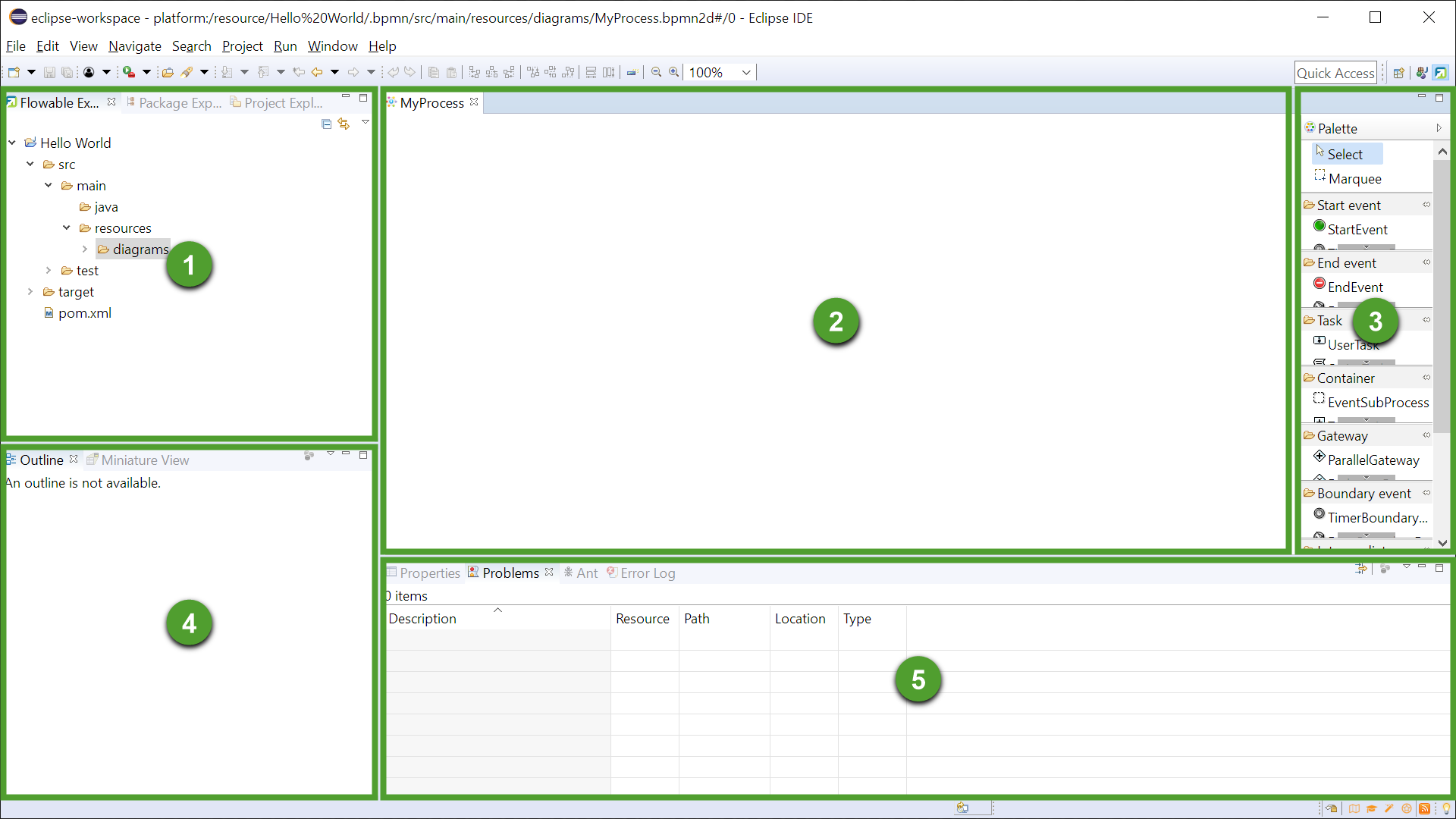
|
Element |
Name |
Description |
|---|---|---|
|
1 |
Flowable Explorer |
A tree list display of files and folders associated with the current project. |
|
2 |
Shared Area - Diagram |
When a diagram is selected the left part is displaying the visual representation of the diagram. |
|
3 |
Shared Area - Palette |
When a diagram is selected the right part is displaying a list of diagram tools and components. |
|
4 |
Outline |
The outline of a selected structured file and its elements. |
|
5 |
Properties |
The property fields of the selected diagram component. |
Add a pool and a lane
To help visualize the workflow and identify the process participants, especially in more complex diagrams, you can make use of pools and lanes. Collibra Data Intelligence Cloud workflows usually have one pool that represents the process while lanes represent different participants or roles in the process.
Although lanes are merely visual aids and play no role in the execution of the workflow, use one lane per each stakeholder.
Adding pools and lanes to the workflow is a drag-and-drop operation:
-
From the Container section of the Palette, drag a Pool to the shared area.
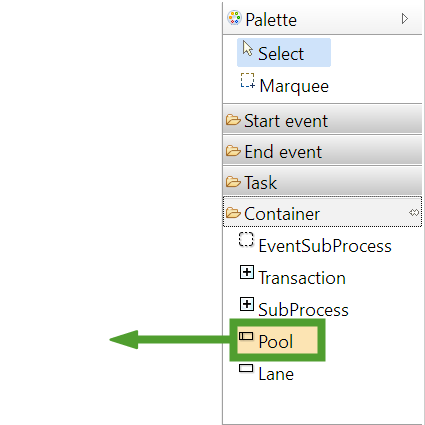
Each pool contains by default one lane.
You now have a pool with one lane.
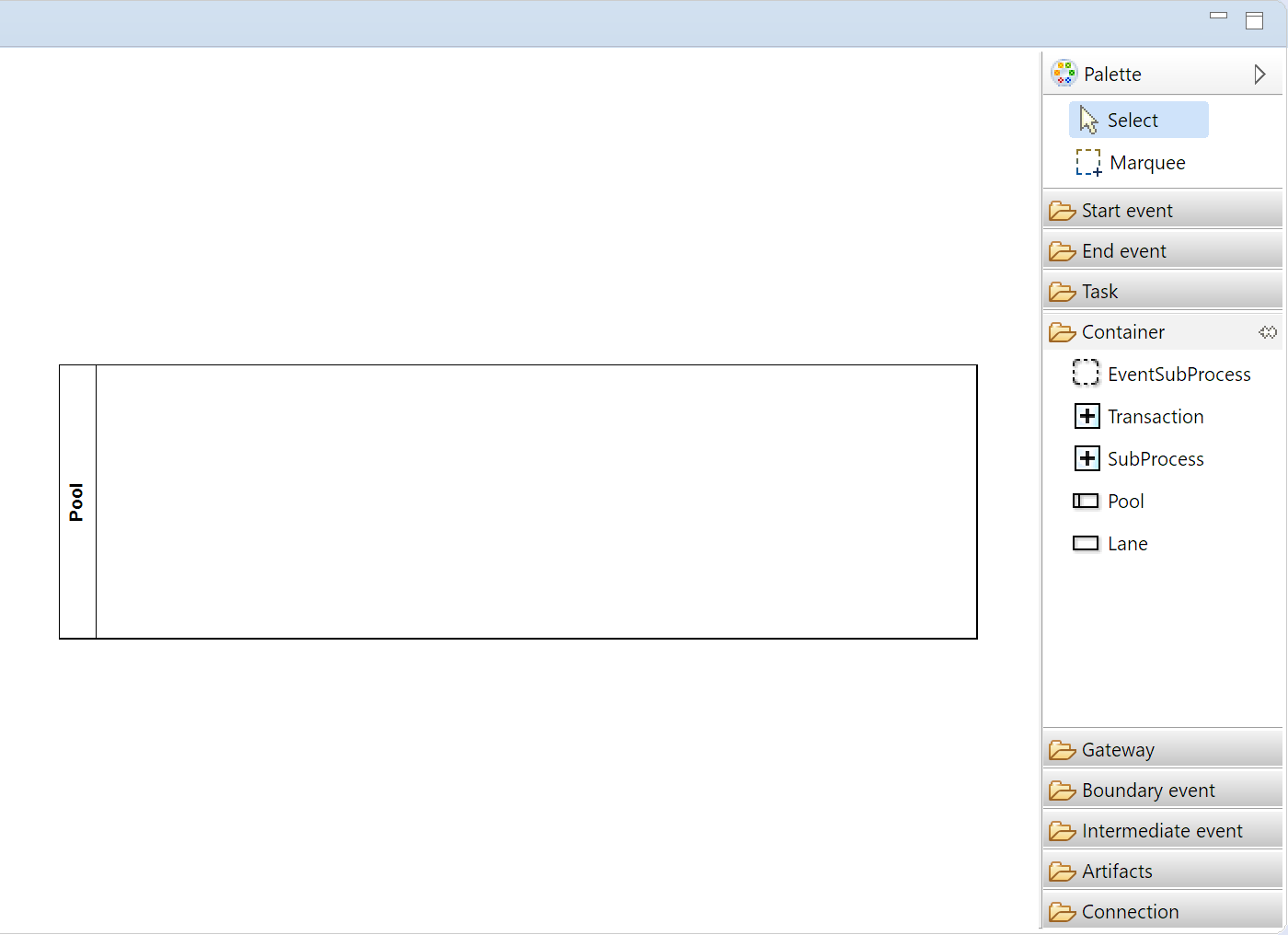
Diagram process properties
The diagram process properties are essential as they reflect directly in Collibra:
- Id: The process ID must be unique at the Collibra environment level.
Uploading a workflow with the same process ID as an existing workflow in Collibra replaces the existing workflow.
Consider using reverse domain name notation for the process ID.
- Name: The name is displayed as the workflow name in Collibra.
Collibra does not accept two workflows with the same display name.
- Documentation: The contents of the field will become the description of the workflow in Collibra.

To configure the pool properties:
- Click the vertical bar of the pool that contains the name to select the pool.
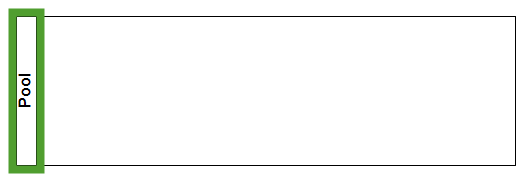
- In the Properties view, select the Process section.
- In the Id field, enter a unique ID for the process. We are using com.collibra.docs.tutorial.hello_world in this example.
- In the Name field, enter a name for the process. We are using Hello World in this example.
-
In the Namespace field, enter http://www.collibra.com/apiv2.
By referencing version 2 of the Collibra Java API, the workflow is validated against V2 methods and deprecated V1 methods trigger a method does not exist error when called.
- In the Documentation field, enter a description of the process.
You can also rename the pool or the lane by changing the Name in the General section. You may change the ID of the pool or the lanes in the General section to make them easier to identify although it is not necessary.
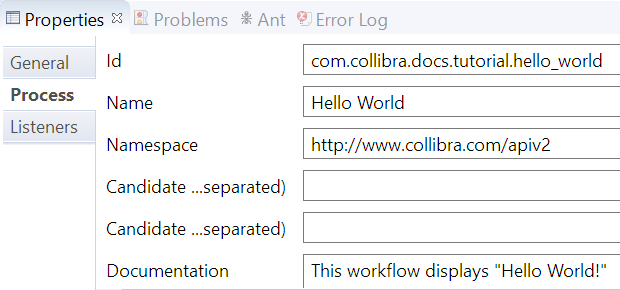
Add a start event and an end event
Events represent something that happens in the process. A start event is the trigger of the process and is depicted as a circle. The end event concludes a process and is depicted as a circle with a bold outline. Each workflow must only have one start event but there may be multiple end events.
To add a start event and an end event to the lane:
-
From the Start event section of the Palette, drag a StartEvent to the pool.
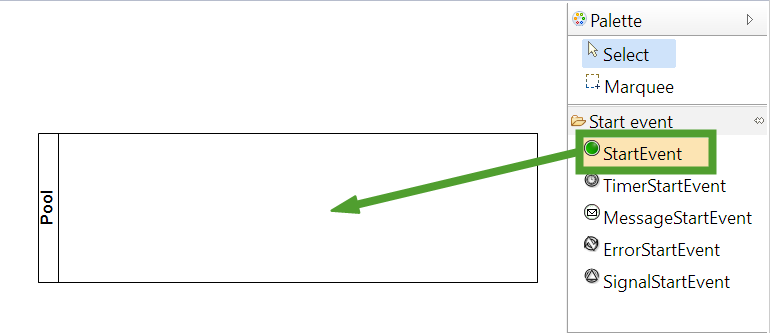
-
From the End event section of the Palette, drag an EndEvent to the pool.

You now have the basic frame for building a Collibra workflow.
Save your work. Commit your changes if using a version control system such as Git.
Create a user task
A task is a single unit of work, something that must be done manually or automatically and is depicted as a rounded-corner rectangle.
To add a task to the workflow and complete diagram:
-
From the Task section of the Palette, drag a UserTask to the pool.
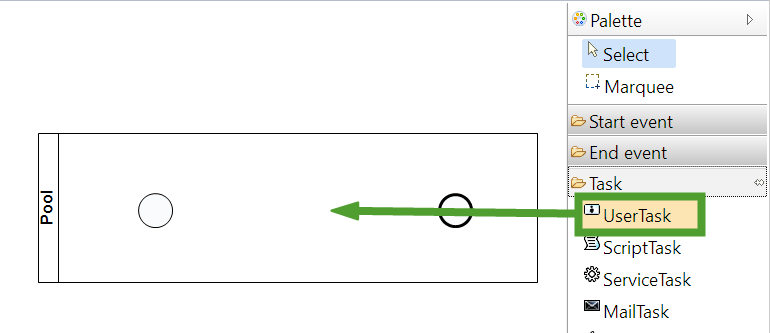
-
Hover the pointer over the start event and drag the Connection icon over the user task.

-
Hover the pointer over the user task and drag the Connection icon over the end event.

Assign a user to the task
You need to assign the user task to a user.
While developing a workflow, you should assign yourself to the tasks you are creating. The real user assignments should be completed towards the end of the testing process.
We are assigning the task to the same user who starts the workflow.
To define the user who starts the workflow:
- In the shared area, select the start event.
- In the Properties view, select the Main config section.
- In the Initiator field, enter a name for the variable that defines the user who starts the workflow. We are using startUser in this example.
The value of the variable becomes the username of that user.
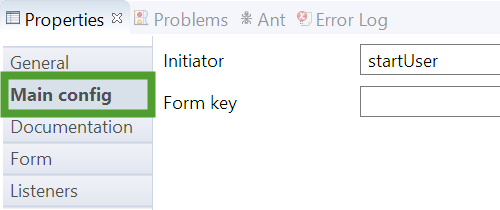
- Select the user task.
- In the Properties view, select the Main config section.
- In the Candidate users field enter user(${startUser}).
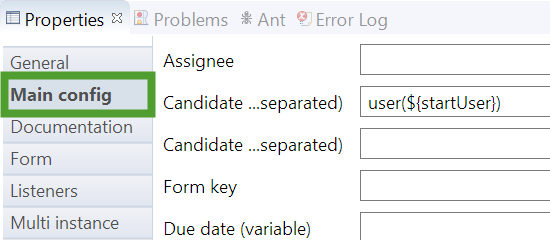
This assigns the task to the user who started the workflow defined by the variable
startUser. The variable is called by enclosing it inside an expression:${}. The value of the variable is then assigned to theuser()object.
Configure the user task
Next, configure the task to display a message:
- Select the user task.
- In the Properties view, select the General section.
- In the Name field, enter a title for the task. We are using Hello World! in this example.
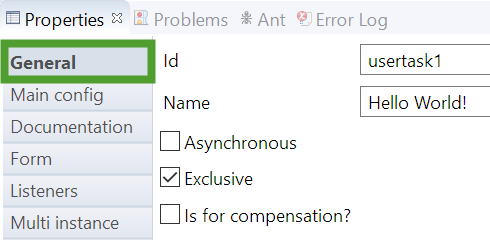
- In the Properties view, select the Documentation section.
- In the Documentation field, enter a description for the task. We are using Press "Done" to close this message. in this example.

The task properties will be reflected in Collibrawhen the task is active:

Save your work.
Upload the BPMN file to Collibra
- Sign in to Collibra as a user with the Sysadmin global role or a global role that has at least the Workflow Administration global permission.
-
On the main menu, click
 , and then click
, and then click
 Settings.
Settings.
The Collibra settings page opens. - Click Workflows.
The Workflows settings page appears on the Definitions tab page. - Click
 Upload a file and locate the BPMN file you have just created inside the Eclipse workspace folder.
Upload a file and locate the BPMN file you have just created inside the Eclipse workspace folder.With the BPMN file selected in Eclipse, select Navigate → Show In → System Explorer. An explorer window will open, showing the exact file location. You can now drag and drop the file to the Upload a file section in your browser.
An Activity Queue window displays the upload progress.
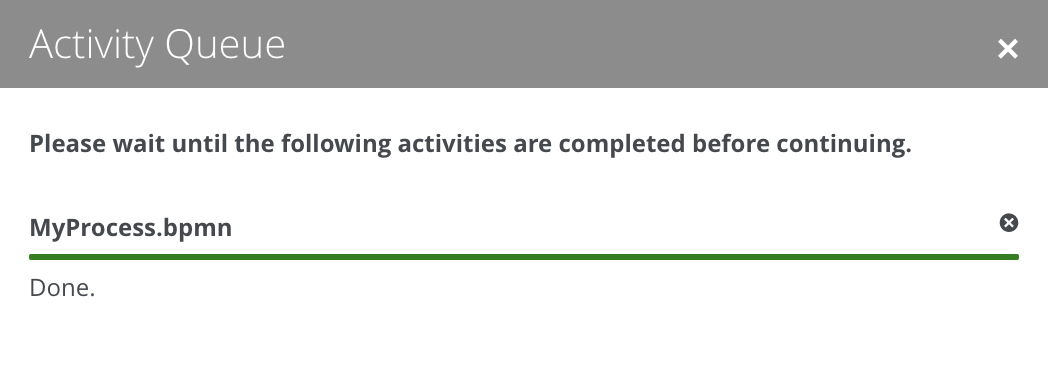
Once the file is uploaded, you see your workflow in the Workflows Definitions table.

For more details, see the Deploy a workflow section of the Collibra Data Intelligence Cloud Administration Guide.
Configure and enable the workflow
When you upload workflows to Collibra, they are automatically deployed but not enabled. Workflows most likely require additional configuration.
The following configuration allows you to start the workflow from a community page.
To configure your workflow:
- Sign in to Collibra as a user with the Sysadmin global role or a global role that has at least the Workflow Administration global permission.
-
On the main menu, click
 , and then click
, and then click
 Settings.
Settings.
The Collibra settings page opens. - In the tab pane, click Workflows → Definitions.
- Click the name of the workflow.
- In the Applies To section, click the edit icon
 .
. - Select Community from the drop-down menu and click Save.
- To confirm the change, click Yes in the dialog box.
The current workflow status is Disabled. To enable the workflow, click the ![]() icon in the title bar, in the upper-right part of the page.
icon in the title bar, in the upper-right part of the page.

Start the workflow
Workflows may be configured to be available in different sections of the Collibra Data Intelligence Cloud or to different roles but in this example, we have configured the workflow so that you may start it from a community page.
Navigate to any community page. We have selected the out of the box Business Analysts Communityin this example.

Depending on the level of customization of your Collibra environment, the logo and the available communities might differ.
To start the workflow, click the button with the workflow name in the title bar, under the name of the community.

A notification indicates the workflow has started.
You see the green task bar appear under the title bar with the values defined previously for title and additional text.
To complete the workflow, click Done at the right of the task bar.

The workflow ends, and task bar closes.
If you would like to start the workflow again, press the button with the workflow name in the title bar.
For additional details, see the Enable or disable a workflow section of the Collibra Data Intelligence Cloud Administration Guide and the Using workflows section of the Collibra User Guide.
Troubleshooting
Upload errors
In case of errors, the workflow does not upload, and an error message is displayed.

The logs contain more information about the error:
- Open Collibra Console.
Collibra Console opens with the Infrastructure page. - Click the name of the environment you deployed the workflow in to display its details.
- Select Data Governance Center.
- Select Logs → dgc.log
Look for errors related to the workflow upload.

Next steps
You have created, deployed and tested your first Collibra workflow which displays a title and a description.
The next tutorial will show you how to further configure user tasks.
Additional resources
- Read the Getting started with workflows Collibra Administration Guide section.
- Read the Using workflows Collibra User Guide section.
- Consult the Flowable user guide.